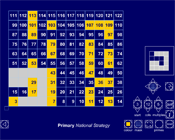Consolidation and practice
These resources are to support children in guided or independent work. Roll over the highlighted resource for a description.
Number grid

This interactive teaching program (ITP) is an ICT-based tool to support the exploration of number, reasoning and problem solving. Number grid ITP allows the child or teacher to generate a number grid with different starting numbers, orientations and numbers of columns. Individual numbers or chosen multiples can be coloured and numbers masked to explore number sequences and patterns and develop children's ability to predict and generalise.
Opportunities to use and apply
Possible contexts include:
- The temperature drops three degrees per day over a week. If the temperature on one Monday is eight degrees, what will the temperature be on the following Monday?
- A submarine is submerging at a rate of 4 m per second. How far below the surface is it after 5 seconds, 10 seconds and 20 seconds?
- In a quiz show, the contestants have 10 seconds to answer a question to get a prize of £20. For every 5 seconds extra they take, they lose £1 from the prize (so if they take 15 seconds, the prize will be £19). Explain what happens to the prize over time.
Confirming learning
Ask probing questions such as:
- The temperature started at four degrees and goes down by 10 degrees. What is the temperature now?
- Megan makes a sequence of numbers, starting with 100. She subtracts 45 each time. Write the next two numbers in the sequence. What would the first two negative numbers be?
- If I count back in steps of four from 9, will –4 be in the count?
How do you know? What about –23?
- If I count back in steps of 33 from 123, how many steps do I have to count back to reach a negative number? Explain your thinking.



 Counting and understanding number
Counting and understanding number
